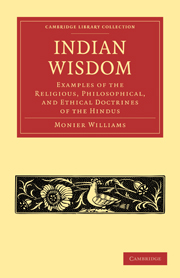Book contents
- Frontmatter
- PREFACE
- THE INDO-ROMANIC ALPHABET WITH THE EQUIVALENT SANSKṚIT LETTERS AND RULES FOR PRONUNCIATION
- Contents
- INTRODUCTION
- LECTURE I The Hymns of the Veda
- LECTURE II The Brāhmana Portion of the Veda
- LECTURE III The Systems of Philosophy
- LECTURE IV The Nyāya System of Philosophy
- LECTURE V The Sānkhya System of Philosophy
- LECTURE VI The Mimāṉsā System of Philosophy
- LECTURE VII Irregular Systems and Eclectic School
- LECTURE VIII Smṛiti. The Vedāngas
- LECTURE IX Smārta-sūtra. Gṛihya, ‘domestic rules’
- LECTURE X The Law-books. Mainu continued
- LECTURE XI Metrical Version of some of Manu's Moral and Religious Precepts
- LECTURE XII The Epic Poems
- LECTURE XIII The Mahā-bhārata
- LECTURE XIV The Epic Poems compared together and with Homer
- LECTURE XV The Artificial Poems
- INDEX
- ADDITIONS AND CORRECTIONS
- ORIENTAL WORKS
LECTURE II - The Brāhmana Portion of the Veda
Published online by Cambridge University Press: 29 August 2010
- Frontmatter
- PREFACE
- THE INDO-ROMANIC ALPHABET WITH THE EQUIVALENT SANSKṚIT LETTERS AND RULES FOR PRONUNCIATION
- Contents
- INTRODUCTION
- LECTURE I The Hymns of the Veda
- LECTURE II The Brāhmana Portion of the Veda
- LECTURE III The Systems of Philosophy
- LECTURE IV The Nyāya System of Philosophy
- LECTURE V The Sānkhya System of Philosophy
- LECTURE VI The Mimāṉsā System of Philosophy
- LECTURE VII Irregular Systems and Eclectic School
- LECTURE VIII Smṛiti. The Vedāngas
- LECTURE IX Smārta-sūtra. Gṛihya, ‘domestic rules’
- LECTURE X The Law-books. Mainu continued
- LECTURE XI Metrical Version of some of Manu's Moral and Religious Precepts
- LECTURE XII The Epic Poems
- LECTURE XIII The Mahā-bhārata
- LECTURE XIV The Epic Poems compared together and with Homer
- LECTURE XV The Artificial Poems
- INDEX
- ADDITIONS AND CORRECTIONS
- ORIENTAL WORKS
Summary
HAVING thus endeavoured to gain an insight into portions of the Vedic Mantras, turn we now to the second division of the Veda, called Brāhmana, or ritualistic precept and illustration. This division stands to the Mantra portion in a relation somewhat resembling that of the Talmud to the Mosaic code and of the Hadīs or Sunna to the Kurān. There is, however, a noteworthy difference; for the Mosaic code alone contains the true revelation of divine law for the Jew, and the Kurān is supposed to do the same for Muslims, whereas the Brāhmaṇas are as much Veda and Śruti—as much revelation, according to the Hindū idea of revelation—as the Mantras.
In fact, in their relation to caste and the dominance of the Brāhmans, these Brāhmaṇas are even more important than the Hymns. When, however, we are asked to explain the contents of the Brāhmaṇas, we find it difficult to define their nature accurately. It is usual to consider them as a body of ritualistic precepts distributed under two heads of Vidhi and Artha-vāda, that is, rules and explanatory remarks. They are really a series of rambling and unsystematic prose compositions (the oldest of which may have been written seven or eight centuries b.c.), intended to serve as ceremonial directories for the use of the priests in the exercise of their craft, prescribing rules for the employment of the Mantras at sacrifices, speculating as to the meaning and effect of certain verses and metres, and giving detailed explanations of the origin, import, and conduct of the sacrifices, with the occasional addition of controversial remarks {nindā) and illustrations in the shape of legends and old stories.
- Type
- Chapter
- Information
- Indian WisdomExamples of the Religious, Philosophical, and Ethical Doctrines of the Hindus, pp. 27 - 47Publisher: Cambridge University PressPrint publication year: 2010First published in: 1875

